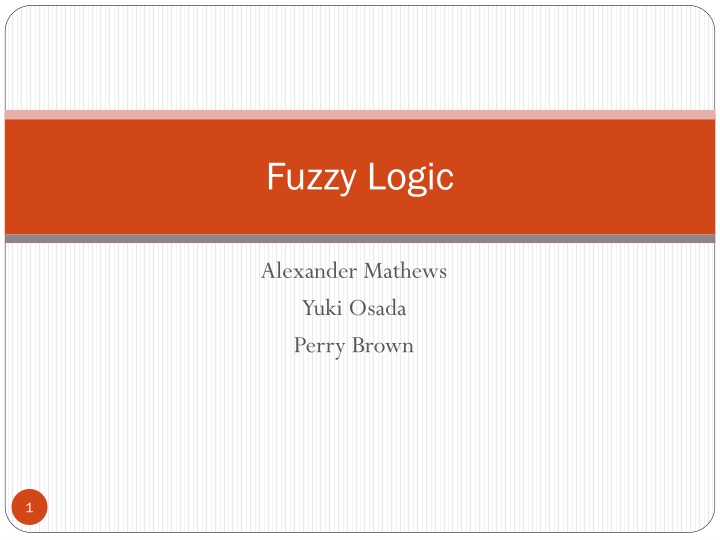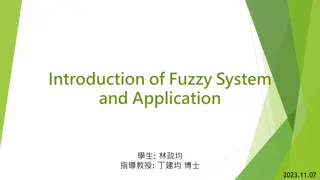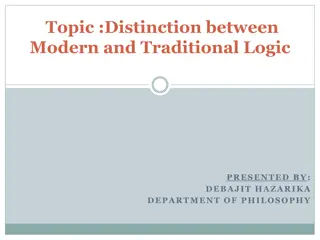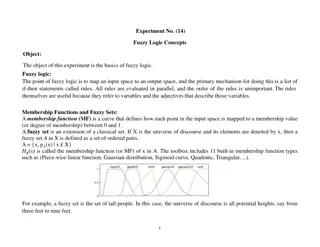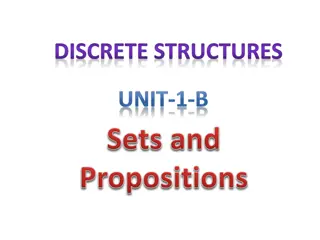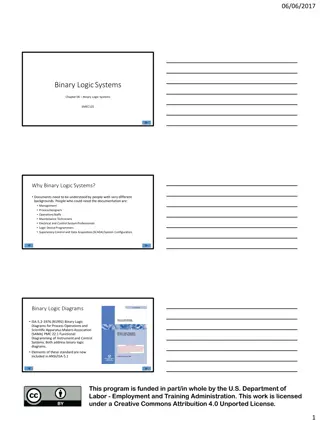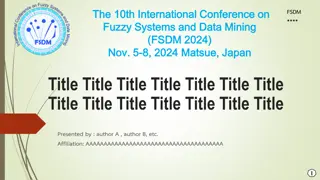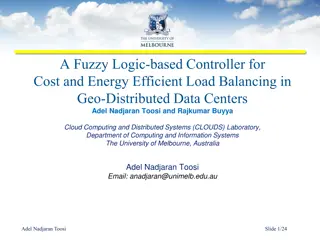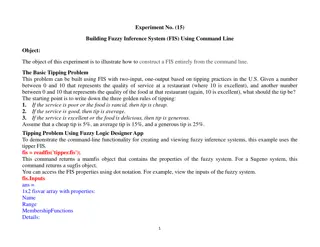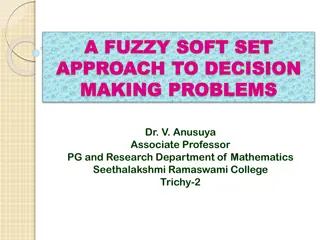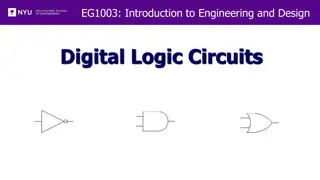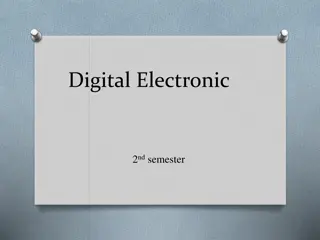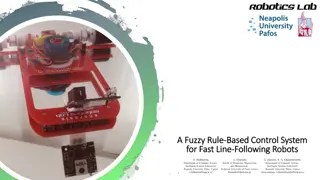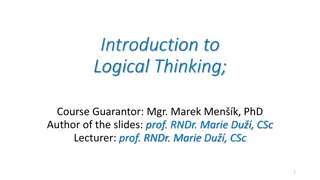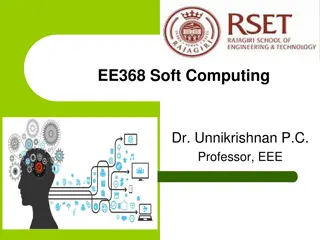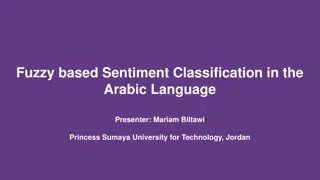Introduction to Fuzzy Logic: Exploring Basic Concepts and Terminologies
Fuzzy logic introduces a spectrum of possibilities between true and false, providing a nuanced approach to reasoning. Learn about fundamental concepts, fuzzification, defuzzification, fuzzy control systems, various algorithms, and real-world applications in this introductory guide.
Uploaded on Feb 19, 2025 | 1 Views
Download Presentation

Please find below an Image/Link to download the presentation.
The content on the website is provided AS IS for your information and personal use only. It may not be sold, licensed, or shared on other websites without obtaining consent from the author.If you encounter any issues during the download, it is possible that the publisher has removed the file from their server.
You are allowed to download the files provided on this website for personal or commercial use, subject to the condition that they are used lawfully. All files are the property of their respective owners.
The content on the website is provided AS IS for your information and personal use only. It may not be sold, licensed, or shared on other websites without obtaining consent from the author.
E N D
Presentation Transcript
Fuzzy Logic Alexander Mathews Yuki Osada Perry Brown 1
Outline Fundamental fuzzy concepts Fuzzy propositional and predicate logic Fuzzification Defuzzification Fuzzy control systems Types of fuzzy algorithms Applications of fuzzy logic 2
Introduction Fuzzy concepts first introduced by Zadeh in the 1960s and 70s Traditional computational logic and set theory is all about true or false zero or one in or out (in terms of set membership) black or white (no grey) Not the case with fuzzy logic and fuzzy sets! 3
Basic Concepts Approximation ( granulation ) A colour can be described precisely using RGB values, or it can be approximately described as red , blue , etc. Degree ( graduation ) Two different colours may both be described as red , but one is considered to be more red than the other Fuzzy logic attempts to reflect the human way of thinking 4
Terminology Fuzzy set A set X in which each element y has a grade of membership X(y) in the range 0 to 1, i.e. set membership may be partial e.g. if cold is a fuzzy set, exact temperature values might be mapped to the fuzzy set as follows: 15 degrees 0.2 (slightly cold) 10 degrees 0.5 (quite cold) 0 degrees 1 (totally cold) Fuzzy relation Relationships can also be expressed on a scale of 0 to 1 e.g. degree of resemblance between two people 5
Terminology (contd) Fuzzy variable Variable with (labels of) fuzzy sets as its values Linguistic variable Fuzzy variable with values that are words or sentences in a language e.g. variable colour with values red, blue, yellow, green Linguistic hedge Term used as a modifier for basic terms in linguistic values e.g. words such as very, a bit, rather, somewhat, etc. 6
Formal Fuzzy Logic Fuzzy logic can be seen as an extension of ordinary logic, where the main difference is that we use fuzzy sets for the membership of a variable We can have fuzzy propositional logic and fuzzy predicate logic Fuzzy logic can have many advantages over ordinary logic in areas like artificial intelligence where a simple true/false statement is insufficient 7
Traditional Logic Propositional logic: Propositional logic is a formal system that uses true statements to form or prove other true statements There are two types of sentences: simple sentences and compound sentences Simple sentences are propositional constants; statements that are either true or false Compound sentences are formed from simpler sentences by using negations , conjunctions , disjunctions , implications , reductions , and equivalences Predicate logic: Onto propositional logic, this adds the ability to quantify variables, so we can manipulate statements about all or some things Two common quantifiers are the existential and universal quantifiers 8
Formal Fuzzy Logic Fuzzy Propositional Logic Like ordinary propositional logic, we introduce propositional variables, truth- functional connectives, and a propositional constant 0 Some of these include: Monoidal t-norm-based propositional fuzzy logic Basic propositional fuzzy logic ukasiewicz fuzzy logic G del fuzzy logic Product fuzzy logic Rational Pavelka logic Fuzzy Predicate Logic These extend fuzzy propositional logic by adding universal and existential quantifiers in a manner similar to the way that predicate logic is created from propositional logic 9
Simple Fuzzy Operators As described by Zadeh (1973) NOT X = 1 - X(y) e.g. 0.8 cold (1 0.8) = 0.2 NOT cold X OR Y (union) = max( X(y), Y(y)) e.g. 0.8 cold, 0.5 rainy 0.8 cold OR rainy X AND Y (intersection) = min( X(y), Y(y)) e.g. 0.9 hot, 0.7 humid 0.7 hot AND humid 10
Alternative Interpretations of AND and OR Zadeh s definition of AND used the G del t-norm, but other definitions are possible using different t-norms Common examples: Product t-norm: X(y) * Y(y) e.g. 0.9 hot, 0.7 humid 0.63 hot AND humid Lukasiewicz t-norm: max( X(y) + Y(y) - 1, 0) e.g. 0.9 hot, 0.7 humid 0.6 hot AND humid Similar possibilities for OR using corresponding t-conorms: Product t-conorm: X(y) + Y(y) - X(y) * Y(y) e.g. 0.8 cold, 0.5 rainy 0.9 cold OR rainy Lukasiewicz t-conorm: min( X(y) + Y(y), 1) e.g. 0.8 cold, 0.5 rainy 1 cold OR rainy 11
Fuzzy System Overview When making inferences, we want to clump the continuous numerical values into sets Unlike Boolean logic, fuzzy logic uses fuzzy sets rather than crisp sets to determine the membership of a variable This allows values to have a degree of membership with a set, which denotes the extent to which a proposition is true The membership function may be triangular, trapezoidal, Gaussian or any other shape 12
Fuzzification To apply fuzzy inference, we need our input to be in linguistic values These linguistic values are represented by the degree of membership in the fuzzy sets The process of translating the measured numerical values into fuzzy linguistic values is called fuzzification In other words, fuzzification is where membership functions are applied, and the degree of membership is determined 13
Membership Functions There are largely three types of fuzzifiers: singleton fuzzifier, Gaussian fuzzifier, and trapezoidal or triangular fuzzifier Gaussian Trapezoidal 14
Defuzzification Defuzzification is the process of producing a quantifiable result in fuzzy logic The fuzzy inference will output a fuzzy result, described in terms of degrees of membership of the fuzzy sets Defuzzification interprets the membership degrees in the fuzzy sets into a specific action or real-value 15
Methods of Defuzzification There are many methods for defuzzification One of the more common types of defuzzification technique is the maximum defuzzification techniques. These select the output with the highest membership function They include: First of maximum Middle of maximum Last of maximum Mean of maxima Random choice of maximum 16
Methods of Defuzzification Given the fuzzy output: The first of maximum, middle of maximum, and last of maximum would be -2, -5, and -8 respectively as seen in the diagram The mean would give the same result as middle unless there is more than one plateau with the maximum value Image Source: http://www.mathworks.com.au/products/fuzzy- logic/examples.html?file=/products/demos/shipping/fuzzy/defuzzdm.html 17
Methods of Defuzzification Two other common methods are: Centre of gravity: Calculates the centre of gravity for the area under the curve Bisector method: Finds the value where the area on one side of that value is equal to the area on the other side Image Source: http://www.mathworks.com.au/products/fuzzy- logic/examples.html?file=/products/demos/shipping/fuzzy/defuzzdm.html 18
Fuzzy Control Systems A simple example application: an automated cooling fan that can adjust its speed according to the room temperature Temperature values are mapped to the fuzzy sets cold, warm and hot based on the following mapping functions for each: Image: http://en.wikipedia.org/w/index.php?title=File:Fuzzy_logic_temperature_en.svg&page=1 19
Fuzzy Control Systems The inference engine in a fuzzy system consists of linguistic rules The linguistic rules consist of two parts: an antecedent block (the conditions), which consists of the linguistic variables a consequent block (the output) Fuzzy algorithm Algorithm that includes at least some fuzzy instructions, such as conditional or unconditional action statements Fuzzy conditional statement (A B) Conditional statement in which A and/or B are fuzzy sets e.g. IF temperature is hot THEN fan speed is high Defined in terms of a fuzzy relation between the respective universes of discourse of A and B (compositional rule of inference) e.g. relation between temperature groupings and fan speeds 20
A Simple Fuzzy Algorithm Example The algorithm used by our cooling fan controller might look like this: WHILE fan is switched on IF cold THEN stop fan IF warm AND NOT cooling down THEN increase fan speed slightly IF hot THEN increase fan speed substantially etc 21
Types of Fuzzy Algorithms Definitional algorithms Define a fuzzy set or calculate grades of membership of elements, e.g.: handwritten characters (what could an M look like?) measures of proximity (what counts as close?) Generational algorithms Generate a fuzzy set e.g. an arbitrary sentence in some natural language that needs to be grammatically valid according to various rules 22
Types of Fuzzy Algorithms (contd) Relational algorithms Describe a relation between fuzzy variables Can be used to approximately describe behaviour of a system e.g. in our cooling fan example, describing the relation between the input variable (temperature) and output variable (fan speed) Decisional algorithms Approximately describe a strategy for performing some task, e.g.: approaching a set of traffic lights (should we slow down, stop or proceed at current speed?) navigating a robot towards a goal while avoiding obstacles 23
Applications of Fuzzy Logic Control Systems Consumer systems automatic transmissions washing machines camera autofocus Industrial systems aircraft engines power supply regulation steam turbine start-up A commercial tool for building embedded fuzzy systems Image source: http://www.bytecraft.com/Fuzz-C__Fuzzy_Logic_Preprocessor 24
Applications of Fuzzy Logic Artificial Intelligence Robot motion planning Image segmentation Medical diagnosis systems 25
Fuzzy Logic Control Systems Why use fuzzy logic for control? Simple systems: Low development costs Low maintenance costs Complex systems: Reduced run-time Reduced search space for efficient optimisation How can fuzzy logic achieve this? 26
Fuzzy Control System Development Fuzzy logic: Is used to quickly translate from expert knowledge to code Expert knowledge reduces the search space when optimising the system 27
Fuzzy Control System Development 1. Identify performance measure 2. Select input/output variables 3. Determine fuzzy rules Talking to an expert Data mining 4. Decide on membership functions for the fuzzy variables 5. Tune membership functions and/or rules 28
Aircraft Engine Control Engine: General Electric's LV100 Turboshaft engine Existing solution: 10 low level controllers Only one controller runs at a time The controller is selected based on current conditions (a crisp mode selector) Problem: Abrupt changes when switching controllers Poor fuel economy High peak operating temperature Schematic of the LV100 engine. An AGT1500 Turboshaft engine being installed into a tank. The AGT1500 is the predecessor to the LV100. Top Image Source: Bonissone et al. 1995 Bottom Image Source: http://en.wikipedia.org/wiki/Honeywell_AGT1500 29
Engine Control: Solution Replace the crisp mode selector with: A Fuzzy Supervisor 24 operation modes 24 operation rules Blend outputs of existing controllers Result (from simulation): Significantly reduced fuel consumption Did not achieve desired reduction in operating temperature 30
Engine Control: Solution 2 Hierarchical fuzzy control system Use a fuzzy supervisor Replace the low level controllers with fuzzy controllers 6 fuzzy controllers used, 49 rules each Controllers govern: fuel flow, turbine nozzle area Fuzzy controllers act on small time scales Fuzzy supervisor acts on large time scales 31
Engine Control: Results Reduced fuel consumption Lower maximum temperature Increased component life Improved performance Development time was of the time taken to develop the existing control system 32
Image Segmentation Decompose an image into regions Regions have similar properties Colour, Texture Can be a clustering problem or a classification problem An example of licence plate segmentation. An example of image segmentation. The input image is on the left. The output image is on the right. Top Image Source: http://en.wikipedia.org/wiki/Automatic_number_plate_recognition Bottom Image Source: www.cs.toronto.edu/~jepson/csc2503/segmentation.pdf 33
Neuro-Fuzzy Image Segmentation 1. Decide on the number of fuzzy variables (number of regions) 2. Calculate the grey-scale histogram 3. Apply fuzzy c-Means (FCM) to get membership functions a) a grey scale histogram b) three fuzzy membership functions for (a) Image Source: Boskovitz & Guterman 2002 34
Neuro-Fuzzy Image Segmentation 4. Pass the MxN image through an LP with layers of size MxN 5. Fuzzify the pixels in the output layer The structure of the neural network. Circles are neurons. Arrows are connections between neurons. Image Source: Boskovitz & Guterman 2002 35
Neuro-Fuzzy Image Segmentation 6. Calculate the total fuzziness (entropy) of the output 7. Using fuzzy entropy as the error function, train the MLP with back-propagation b) three fuzzy membership functions for histogram (a) d) the fuzziness of each possible grey-scale value Image Source: Boskovitz & Guterman 2002 36
Neuro-Fuzzy Image Segmentation Input panda image Output panda image Image Source: Boskovitz & Guterman 2002 37
References General Zadeh, L.A., Outline of a New Approach to the Analysis of Complex Systems and Decision Processes , Systems, Man, and Cybernetics, IEEE Transactions on, 1973 Volume 3, Number 1, 28--44. M. Navara. (2007). Triangular norms and conorms Scholarpedia [Online]. Available: http://www.scholarpedia.org/article/Triangular_norms_and_conorms Unknown author. (2010). Fuzzy Logic Example [Online]. Available: http://petro.tanrei.ca/fuzzylogic/index.html 38
References Applications Bonissone, P.P. and Badami, V. and Chiang, K.H. and Khedkar, P.S. and Marcelle, K.W. and Schutten, M.J., Industrial applications of fuzzy logic at General Electric , Proceedings of the IEEE, 1995, Volume 83, 450--465 Boskovitz, V. and Guterman, H., An adaptive neuro-fuzzy system for automatic image segmentation and edge detection , Fuzzy Systems, IEEE Transactions on, 2002, Volume 10, 247--262 Klement, E.P. and Slany, W., Fuzzy logic in artificial intelligence , Christian Doppler Laboratory Technical Reports, 1994, Volume 67 39
